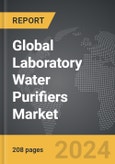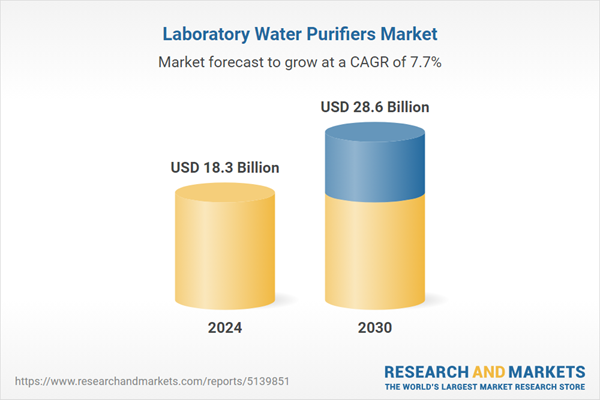The global market for Laboratory Water Purifiers was valued at US$18.3 Billion in 2024 and is projected to reach US$28.6 Billion by 2030, growing at a CAGR of 7.7% from 2024 to 2030. This comprehensive report provides an in-depth analysis of market trends, drivers, and forecasts, helping you make informed business decisions. The report includes the most recent global tariff developments and how they impact the Laboratory Water Purifiers market.
Segments: Type (Type I, Type II, Type III); End-Use (Healthcare, Research Organizations & Institutes, Other End-Uses).
Geographic Regions/Countries: World; United States; Canada; Japan; China; Europe (France; Germany; Italy; United Kingdom; Spain; Russia; and Rest of Europe); Asia-Pacific (Australia; India; South Korea; and Rest of Asia-Pacific); Latin America (Argentina; Brazil; Mexico; and Rest of Latin America); Middle East (Iran; Israel; Saudi Arabia; United Arab Emirates; and Rest of Middle East); and Africa.
The analysts continuously track trade developments worldwide, drawing insights from leading global economists and over 200 industry and policy institutions, including think tanks, trade organizations, and national economic advisory bodies. This intelligence is integrated into forecasting models to provide timely, data-driven analysis of emerging risks and opportunities.
Global Laboratory Water Purifiers Market - Key Trends & Drivers Summarized
Why Are Water Purifiers Critical in Laboratory Operations?
Laboratory water purifiers are critical components in laboratory operations, ensuring that the water used in experiments, analyses, and equipment cleaning is of the highest purity. Contaminants in water, even at trace levels, can significantly impact the accuracy and reliability of scientific results. Therefore, laboratories require water purification systems that can consistently produce water of specific grades, such as Type I, Type II, and Type III, depending on the application. These systems are essential in various fields, including chemistry, biology, and pharmaceuticals, where the quality of water directly influences the outcomes of experiments and the integrity of research data. As laboratories increasingly emphasize precision and reliability, the demand for advanced water purification systems continues to grow.How Are Technological Innovations Driving the Evolution of Laboratory Water Purifiers?
Technological innovations are driving the evolution of laboratory water purifiers, leading to more efficient, reliable, and user-friendly systems. Modern water purifiers incorporate advanced filtration technologies, such as reverse osmosis, UV sterilization, and deionization, to remove a wide range of contaminants, including organic compounds, ions, and microorganisms. Additionally, the integration of smart technology allows for real-time monitoring of water quality, automated system maintenance, and remote access, ensuring that laboratories can maintain consistent water purity with minimal manual intervention. Innovations in energy efficiency and system design are also making water purifiers more sustainable and cost-effective, reducing operational costs and environmental impact. These technological advancements are not only enhancing the performance of water purification systems but also expanding their applicability across a broader range of laboratory environments.What Challenges Are Associated with Maintaining Laboratory Water Purity?
Maintaining consistent water purity in laboratory settings presents several challenges, including the cost of high-end purification systems, the need for regular maintenance, and the potential for system downtime. The initial investment in advanced water purification systems can be substantial, particularly for laboratories that require water of the highest purity. Regular maintenance, including filter replacement and system calibration, is essential to ensure that these systems continue to function effectively, which can add to operational costs and require specialized technical knowledge. Additionally, any downtime in the water purification system can disrupt laboratory operations and compromise the quality of experimental results. To address these challenges, manufacturers are developing more robust and user-friendly systems, offering comprehensive maintenance packages, and providing technical support to ensure that laboratories can maintain optimal water purity with minimal disruption.What Factors Are Driving Growth in the Laboratory Water Purifiers Market?
The growth in the laboratory water purifiers market is driven by several factors, including the increasing complexity of laboratory research, the expansion of pharmaceutical and biotechnology industries, and the continuous advancements in water purification technology. As research in areas such as genomics, molecular biology, and analytical chemistry becomes more complex, the need for ultra-pure water becomes increasingly critical. The expansion of pharmaceutical and biotechnology industries, which require stringent control over the quality of water used in drug development and manufacturing, is also driving demand for advanced water purification systems. Additionally, ongoing advancements in purification technology, including smart monitoring systems and energy-efficient designs, are making these systems more accessible and effective, further supporting their adoption. As these trends continue, the laboratory water purifiers market is expected to grow, driven by the need for reliability, precision, and innovation in laboratory water management.Report Scope
The report analyzes the Laboratory Water Purifiers market, presented in terms of units. The analysis covers the key segments and geographic regions outlined below.Segments: Type (Type I, Type II, Type III); End-Use (Healthcare, Research Organizations & Institutes, Other End-Uses).
Geographic Regions/Countries: World; United States; Canada; Japan; China; Europe (France; Germany; Italy; United Kingdom; Spain; Russia; and Rest of Europe); Asia-Pacific (Australia; India; South Korea; and Rest of Asia-Pacific); Latin America (Argentina; Brazil; Mexico; and Rest of Latin America); Middle East (Iran; Israel; Saudi Arabia; United Arab Emirates; and Rest of Middle East); and Africa.
Key Insights:
- Market Growth: Understand the significant growth trajectory of the Type I segment, which is expected to reach US$10.1 Billion by 2030 with a CAGR of a 7.7%. The Type II segment is also set to grow at 8.2% CAGR over the analysis period.
- Regional Analysis: Gain insights into the U.S. market, valued at $4.9 Billion in 2024, and China, forecasted to grow at an impressive 11.2% CAGR to reach $6.2 Billion by 2030. Discover growth trends in other key regions, including Japan, Canada, Germany, and the Asia-Pacific.
Why You Should Buy This Report:
- Detailed Market Analysis: Access a thorough analysis of the Global Laboratory Water Purifiers Market, covering all major geographic regions and market segments.
- Competitive Insights: Get an overview of the competitive landscape, including the market presence of major players across different geographies.
- Future Trends and Drivers: Understand the key trends and drivers shaping the future of the Global Laboratory Water Purifiers Market.
- Actionable Insights: Benefit from actionable insights that can help you identify new revenue opportunities and make strategic business decisions.
Key Questions Answered:
- How is the Global Laboratory Water Purifiers Market expected to evolve by 2030?
- What are the main drivers and restraints affecting the market?
- Which market segments will grow the most over the forecast period?
- How will market shares for different regions and segments change by 2030?
- Who are the leading players in the market, and what are their prospects?
Report Features:
- Comprehensive Market Data: Independent analysis of annual sales and market forecasts in US$ Million from 2024 to 2030.
- In-Depth Regional Analysis: Detailed insights into key markets, including the U.S., China, Japan, Canada, Europe, Asia-Pacific, Latin America, Middle East, and Africa.
- Company Profiles: Coverage of players such as BIOBASE, Biosan Laboratories, Inc., Danaher Corporation, Merck KgaA, SUEZ Water Technologies & Solutions and more.
- Complimentary Updates: Receive free report updates for one year to keep you informed of the latest market developments.
Some of the 12 companies featured in this Laboratory Water Purifiers market report include:
- BIOBASE
- Biosan Laboratories, Inc.
- Danaher Corporation
- Merck KgaA
- SUEZ Water Technologies & Solutions
- Veolia Water Technologies
Tariff Impact Analysis: Key Insights for 2025
Global tariff negotiations across 180+ countries are reshaping supply chains, costs, and competitiveness. This report reflects the latest developments as of April 2025 and incorporates forward-looking insights into the market outlook.The analysts continuously track trade developments worldwide, drawing insights from leading global economists and over 200 industry and policy institutions, including think tanks, trade organizations, and national economic advisory bodies. This intelligence is integrated into forecasting models to provide timely, data-driven analysis of emerging risks and opportunities.
What’s Included in This Edition:
- Tariff-adjusted market forecasts by region and segment
- Analysis of cost and supply chain implications by sourcing and trade exposure
- Strategic insights into geographic shifts
Buyers receive a free July 2025 update with:
- Finalized tariff impacts and new trade agreement effects
- Updated projections reflecting global sourcing and cost shifts
- Expanded country-specific coverage across the industry
Table of Contents
I. METHODOLOGYII. EXECUTIVE SUMMARY2. FOCUS ON SELECT PLAYERSIII. MARKET ANALYSISIV. COMPETITION
1. MARKET OVERVIEW
3. MARKET TRENDS & DRIVERS
4. GLOBAL MARKET PERSPECTIVE
UNITED STATES
CANADA
JAPAN
CHINA
EUROPE
FRANCE
GERMANY
ITALY
UNITED KINGDOM
SPAIN
RUSSIA
REST OF EUROPE
ASIA-PACIFIC
AUSTRALIA
INDIA
SOUTH KOREA
REST OF ASIA-PACIFIC
LATIN AMERICA
ARGENTINA
BRAZIL
MEXICO
REST OF LATIN AMERICA
MIDDLE EAST
IRAN
ISRAEL
SAUDI ARABIA
UNITED ARAB EMIRATES
REST OF MIDDLE EAST
AFRICA
Companies Mentioned (Partial List)
A selection of companies mentioned in this report includes, but is not limited to:
- BIOBASE
- Biosan Laboratories, Inc.
- Danaher Corporation
- Merck KgaA
- SUEZ Water Technologies & Solutions
- Veolia Water Technologies
Table Information
| Report Attribute | Details |
|---|---|
| No. of Pages | 208 |
| Published | April 2025 |
| Forecast Period | 2024 - 2030 |
| Estimated Market Value ( USD | $ 18.3 Billion |
| Forecasted Market Value ( USD | $ 28.6 Billion |
| Compound Annual Growth Rate | 7.7% |
| Regions Covered | Global |









